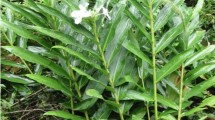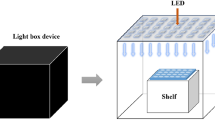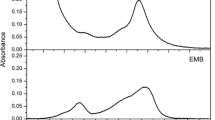Abstract
In this study, photostability and photodynamic antimicrobial performance of dye extracts from Hibiscus sabdariffa (HS) calyces, Sorghum bicolor (SB) leaf sheaths, Lawsonia inermis (LI) leaves and Curcuma longa (CL) roots were investigated in Acetate-HCl (AH) Buffer (pH 4.6), Tris Base-HCl (TBH) Buffer (pH 8.6), distilled water (dH2O), and Phosphate Buffer Saline (PBS, pH 7.2) using Bacillus subtilis as model for gram positive bacteria, Escherichia coli as model for gram negative bacteria, phage MS2 as model for non-envelope viruses and phage phi6 as model for envelope viruses including SARS CoV-2 which is the causative agent of COVID-19. Our results showed that the photostability of the dye extracts is in the decreasing order of LI > CL > SB > HS. The dye extract-HS is photostable in dH2O but bleaches in buffers—AH, TBH and PBS. The rate of bleaching is higher in AH compared to in TBH and PBS. The bleaching and buffers affected the photodynamic and non-photodynamic antimicrobial activity of the dye extracts. The photodynamic antibacterial activity of the dye extracts is in the decreasing order of CL > HS > LI > SB while the non-photodynamic antibacterial activity is in the decreasing order of LI > CL > HS > SB. The non-photodynamic antiviral activity pattern observed is the same as that of non-photodynamic antibacterial activity observed. However, the photodynamic antiviral activity of the dye extracts is in the decreasing order of CL > LI > HS > SB. Given their performance, the dye extracts maybe mostly suitable for environmental applications including fresh produce and food disinfection, sanitation of hands and contact surfaces where water can serve as diluent for the extracts and the microenvironment is free of salts.
Graphic abstract








Similar content being viewed by others
Data Availability
The authors declare that the data supporting the findings of this study are available within the paper and its Supplementary Information files. Should any raw data files be needed in another format they are available from the corresponding author upon reasonable request.
References
de Oliveira, E. F., Tosati, J. V., Tikekar, R. V., Monteiro, A. R., & Nitin, N. (2018). Antimicrobial activity of curcumin in combination with light against Escherichia coli O157: H7 and Listeria innocua: applications for fresh produce sanitation. Postharvest Biology and Technology, 137, 86–94.
Ghate, V. S., Zhou, W., & Yuk, H. G. (2019). Perspectives and trends in the application of photodynamic inactivation for microbiological food safety. Comprehensive Reviews in Food Science and Food Safety, 18(2), 402–424.
Majiya, H., & Galstyan, A. (2020). Dye extract of calyces of Hibiscus sabdariffa has photodynamic antibacterial activity: A prospect for sunlight-driven fresh produce sanitation. Food Science & Nutrition, 8(7), 3200–3211.
Majiya, H., & Galstyan, A. (2023). Potential of a methanolic extract of Lawsonia inermis (L.) leaf as an alternative sanitiser in the time of COVID-19 pandemic and beyond. Journal of Herbal Medicine, 38, 100633.
Zhu, S., Song, Y., Pei, J., Xue, F., Cui, X., **ong, X., & Li, C. (2021). The application of photodynamic inactivation to microorganisms in food. Food Chemistry: X, 12, 100150.
Ponzio, R. A., Ibarra, L. E., Achilli, E. E., Odella, E., Chesta, C. A., Martínez, S. R., & Palacios, R. E. (2022). Sweet light o’mine: Photothermal and photodynamic inactivation of tenacious pathogens using conjugated polymers. Journal of Photochemistry and Photobiology B: Biology, 234, 112510.
Foresto, E., Gilardi, P., Ibarra, L. E., & Cogno, I. S. (2021). Light-activated green drugs: How we can use them in photodynamic therapy and mass-produce them with biotechnological tools. Phytomedicine Plus, 1(3), 100044.
Polat, E., & Kang, K. (2021). Natural photosensitizers in antimicrobial photodynamic therapy. Biomedicines, 9(6), 584.
Winter, S., Tortik, N., Kubin, A., Krammer, B., & Plaetzer, K. (2013). Back to the roots: Photodynamic inactivation of bacteria based on water-soluble curcumin bound to polyvinylpyrrolidone as a photosensitizer. Photochemical & Photobiological Sciences, 12(10), 1795–1802.
Luksiene, Z., & Paskeviciute, E. (2011). Novel approach to the microbial decontamination of strawberries: Chlorophyllin-based photosensitization. Journal of Applied Microbiology, 110(5), 1274–1283.
Luksiene, Z., & Brovko, L. (2013). Antibacterial photosensitization-based treatment for food safety. Food Engineering Reviews, 5(4), 185–199.
Maisch, T., Spannberger, F., Regensburger, J., Felgenträger, A., & Bäumler, W. (2012). Fast and effective: Intense pulse light photodynamic inactivation of bacteria. Journal of Industrial Microbiology & Biotechnology, 39(7), 1013–1021.
Tavares, A., Dias, S. R. S., Carvalho, C. M. B., Faustino, M. A. F., Tomé, J. P. C., Neves, M. G. P. M. S., & Almeida, A. (2011). Mechanisms of photodynamic inactivation of a gram-negative recombinant bioluminescent bacterium by cationic porphyrins. Photochemical & Photobiological Sciences, 10(10), 1659–1669.
Costa, L., Carvalho, C. M. B., Faustino, M. A. F., Neves, M. G. P. M. S., Tomé, J. P. C., Tomé, A. C., & Almeida, A. (2010). Sewage bacteriophage inactivation by cationic porphyrins: Influence of light parameters. Photochemical & Photobiological Sciences, 9(8), 1126–1133.
Randazzo, W., Aznar, R., & Sánchez, G. (2016). Curcumin-mediated photodynamic inactivation of norovirus surrogates. Food and Environmental Virology, 8(4), 244–250.
Ilori, O. O., & Odukoya, O. A. (2005). Hibiscus sabdarifa and sorghum bicolor as natural colorants. Electronic Journal of Environmental, Agricultural and Food Chemistry, 4, 858–862.
Geera, B., Ojwang, L. O., & Awika, J. M. (2012). New highly stable dimeric 3-deoxyanthocyanidin pigments from Sorghum bicolor leaf sheath. Journal of Food Science, 77(5), C566–C572.
Ekwealor, C. C., & Oyeka, C. A. (2015). In vitro anti dermatophyte activities of crude methanol and aqueous extracts of Lawsonia inermis. International Journal of Pharmaceutical Science and Drug Research, 7, 59–62.
Chaudhary, G., Goyal, S., & Poonia, P. (2010). Lawsonia inermis Linnaeus: A phytopharmacological review. International Journal of Pharmaceutical Science and Drug Research, 2(2), 91–98.
Sharma, R. K., & Goel, A. (2018). Identification of phytoconstituents in Lawsonia inermis Linn. leaves extract by GC-MS and their antibacterial potential. Pharmacognosy Journal, 10, 6.
Theodoro, L. H., Ferro-Alves, M. L., Longo, M., Nuernberg, M. A. A., Ferreira, R. P., Andreati, A., & Garcia, V. G. (2017). Curcumin photodynamic effect in the treatment of the induced periodontitis in rats. Lasers in Medical Science, 32(8), 1783–1791.
Tortik, N., Spaeth, A., & Plaetzer, K. (2014). Photodynamic decontamination of foodstuff from Staphylococcus aureus based on novel formulations of curcumin. Photochemical & Photobiological Sciences, 13, 1402–1409.
Tortik, N., Steinbacher, P., Maisch, T., Spaeth, A., & Plaetzer, K. (2016). A comparative study on the antibacterial photodynamic efficiency of a curcumin derivative and a formulation on a porcine skin model. Photochemical & Photobiological Sciences, 15, 187–195.
Araújo, N. C., Fontana, C. R., Gerbi, M. E. M., & Bagnato, V. S. (2012). Overall-mouth disinfection by photodynamic therapy using curcumin. Photomedicine and laser surgery, 30(2), 96–101.
Paschoal, M. A., Tonon, C. C., Spolidório, D. M., Bagnato, V. S., Giusti, J. S., & Santos-Pinto, L. (2013). Photodynamic potential of curcumin and blue LED against Streptococcus mutans in a planktonic culture. Photodiagnosis and photodynamic therapy, 10(3), 313–319.
Wu, J., Hou, W., Cao, B., Zuo, T., Xue, C., Leung, A. W., & Tang, Q. J. (2015). Virucidal efficacy of treatment with photodynamically activated curcumin on murine norovirus bio-accumulated in oysters. Photodiagnosis and Photodynamic Therapy, 12(3), 385–392.
Santezi, C., Tanomaru, J. M., Bagnato, V. S., Júnior, O. B. O., & Dovigo, L. N. (2016). Potential of curcumin-mediated photodynamic inactivation to reduce oral colonization. Photodiagnosis and Photodynamic Therapy, 15, 46–52.
Abou-Arab, A. A., Abu-Salem, F. M., & Abou-Arab, E. A. (2011). Physicochemical properties of natural pigments (anthocyanin) extracted from Roselle calyces (Hibiscus subdariffa). Journal of American Science, 7(7), 445–456.
Galstyan, A., Ricker, A., Nüsse, H., Klingauf, J., & Dobrindt, U. (2019). Exploring the impact of coordination-driven self assembly on the antibacterial activity of low-symmetry phthalocyanines. ACS Applied Bio Materials, 3(1), 400–411.
Ghate, V., Kumar, A., Zhou, W., & Yuk, H. G. (2015). Effect of organic acids on the photodynamic inactivation of selected foodborne pathogens using 461 nm LEDs. Food Control, 57, 333–340.
Acknowledgements
This research was funded by International Foundation for Science (IFS) and Organisation for the Prohibition of Chemical Weapons (OPCW) grant I3-E-6583-1 to Hussaini Majiya.
Funding
This study was funded by International Foundation for Science (IFS), Stockholm, Sweden, and Organisation for the Prohibition of Chemical Weapons (OPCW) I3-E-6583-1, Hussaini Mohammed Majiya.
Author information
Authors and Affiliations
Contributions
Hussaini Majiya: Conceptualization, Methodology, Formal analysis, Investigation, Writing—original draft, Funding acquisition. Aliyu Adamu: Formal analysis, Data curation, Writing—review and editing. Anzhela Galstyan: Data curation, Writing—review and editing. Ethical consideration Ethics approval was not required for this research.
Corresponding author
Ethics declarations
Conflict of interest
The authors declare that they have no known competing financial interests or personal relationships that could have appeared to influence the work reported in this paper.
Supplementary Information
Below is the link to the electronic supplementary material.
Rights and permissions
Springer Nature or its licensor (e.g. a society or other partner) holds exclusive rights to this article under a publishing agreement with the author(s) or other rightsholder(s); author self-archiving of the accepted manuscript version of this article is solely governed by the terms of such publishing agreement and applicable law.
About this article
Cite this article
Majiya, H., Adamu, A. & Galstyan, A. Photostability and photodynamic antimicrobial profile of dye extracts from four (4) plants: prospects for eco-friendly low-cost food disinfection and topical biomedical applications. Photochem Photobiol Sci 23, 1179–1194 (2024). https://doi.org/10.1007/s43630-024-00585-8
Received:
Accepted:
Published:
Issue Date:
DOI: https://doi.org/10.1007/s43630-024-00585-8




